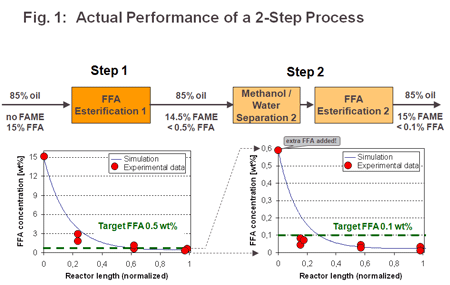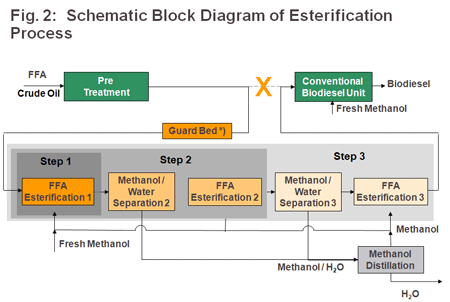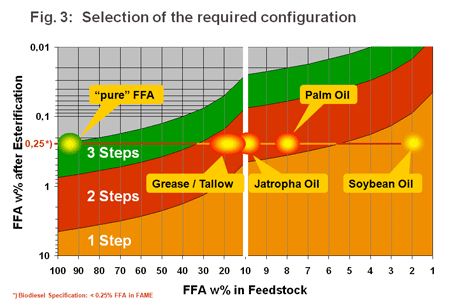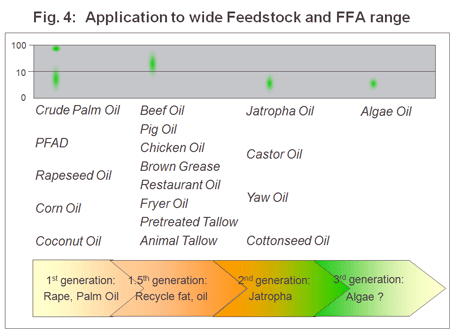Biodiesel, a renewable diesel fuel, is also known as FAME (fatty-acid methyl ester) in the industry. Chemically speaking, biodiesel refers to a vegetable oil- or animal fat-based diesel fuel consisting of long-chain alkyl (methyl, propyl or ethyl) esters. Biodiesel is typically made by chemically reacting lipids (animal fats, vegetable oils or recycled restaurant greases) with an alcohol, and can be used (depending on how it is processed) for heating or transportation fuel in automobiles, trains or airplanes.

Figure 1. Actual performance of a two-step process

Figure 2. Schematic block diagram of esterification process
Biodiesel works just as well as normal diesel fuel, but the combustion process expels lower concentrations of toxic emissions. Biodiesel increases lubrication of ultra low sulfur petroleum diesel, which reduces wear, increases engine life and cleans injectors, fuel pumps and lines.
Biodiesel producers worldwide are looking for ways to lower feedstock cost, increase processing flexibility, increase biodiesel yield, improve biodiesel and glycerol purity and make biodiesel processing simpler and safer. Treatment steps play a large role in the purity of biodiesel and in the overall price of biodiesel production-and thus the overall cost of biodiesel to the end user. Improvements in these purification techniques help producers deliver better-quality biodiesel, enabling the industry to expand its share of the fuels market.

Figure 3. Selection of the required configuration

Figure 4. Application to wide feedstock and FFA range
Today, feedstock price dominates the total manufacturing cost of biodiesel. The feedstock represents 80 percent of the cost of goods, along with the minor factors of investment cost, utilities and labor. Feedstock price and availability is a moving target in today's environment since typical feedstocks like soybean oil and rapeseed oil, which are readily converted into FAME, reached record prices in 2008 of $1,500 per ton and $1,400 per ton, respectively. These prices have remained volatile. Less expensive feedstocks are available, but they contain a significant amount of free fatty acids (FFA) that cannot be processed in conventional biodiesel plants-until now.
A processing technology has been designed that allows feedstocks-including those with high FFA levels-to be converted into biodiesel. This is a complete esterification process, from reaction kinetics, process design, mass to heat balances and equipment design, with global patents filed. Producers can take advantage of feasibility studies, engineering packages or turnkey operations for FFA esterification using the process. This new clean FFA-esterification technology is based on a catalyst and offers biodiesel producers the ability to turn any FFA-containing feed stock into FAME without yield loss, liquid acids and waste.
Whether producers want to use a specific feedstock such as animal fat, used cooking oil, trap grease, jatropha, algae oil or even 100 wt% (weight percent) FFA (such as palm fatty acid distillate, PFAD), or want to achieve a maximum flexibility in feedstock, this new system presents competitive advantage and flexibility in a world of volatile oil and raw material prices. It offers enormous opportunities to recycle waste from industrial operations into a cleaner-burning fuel for transportation and supports sustainability and the development of solutions to environmental challenges and fuel shortages without using food crops like soybeans.
Today, biodiesel purity is not only a market advantage, but also a market necessity. Regulatory bodies are developing increasingly stringent biodiesel quality specifications that require trace materials to be completely removed. Even the smallest traces of soap, catalyst or glycerol must be systematically removed from crude biodiesel to meet stringent international quality specifications.
The system's multi-stage concept offers removal of trace foulants and optimum yield with minimum manufacturing costs. With this technology, today's biodiesel producer can easily progress from first to second and even third generation biodiesel. The appropriate number of reaction and evaporation stages that should be selected depends mainly on the range of FFA content of the prospective feedstock. For feedstocks containing only a few percent FFA, such as crude vegetable oil, a single reaction stage will be mostly sufficient to reduce the FFA concentration to a residual level that can be tolerated in downstream processing.
A two-stage configuration will be suitable for feedstocks with moderate FFA content ranging between 10 to 20 wt% FFA or equivalent mixtures of high-FFA feed with vegetable oils and fats. If a third reaction stage is employed, feedstocks with FFA concentrations up to 100 wt% can be directly esterified. Irrespective of how many stages are used, the potentially problematic FFA initially contained in the feedstock will be converted into FAME after the last reaction stage.
The capital investment costs for the esterification process employing the catalyst will vary depending on the requirements with regard to feedstock, overall capacity, biodiesel process and flexibility. Typical components of the operating costs are depreciation, catalyst, utilities (steam, electricity and cooling water), maintenance and labor. Overall, the savings using an FFA-rich feedstock with esterification technology are significant compared to using conventional technology with feedstocks such as rapeseed or soybean oil.
Companies are accelerating the development of energy alternatives like biodiesel by investing in the development of materials, technologies and business strategies that enable new breakthrough solutions. Companies are developing technologies that give biodiesel producers the freedom to choose the most cost-effective feedstocks, streamline the manufacturing process and gain operational savings. Collaboration is key to growing the biodiesel industry and demonstrating the positive impact alternative fuels can have on the economy, society and environment.
Pumps and Systems, April 2010

